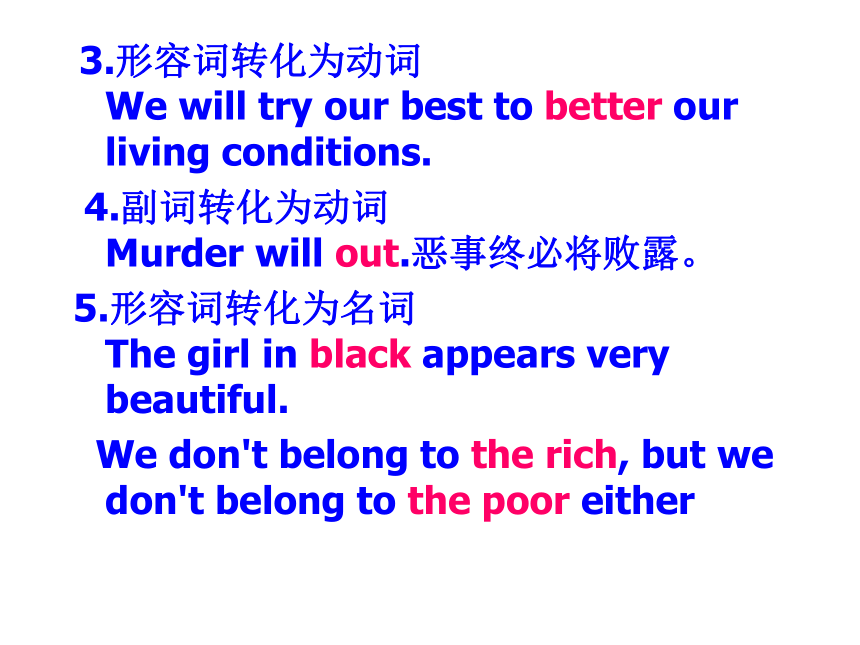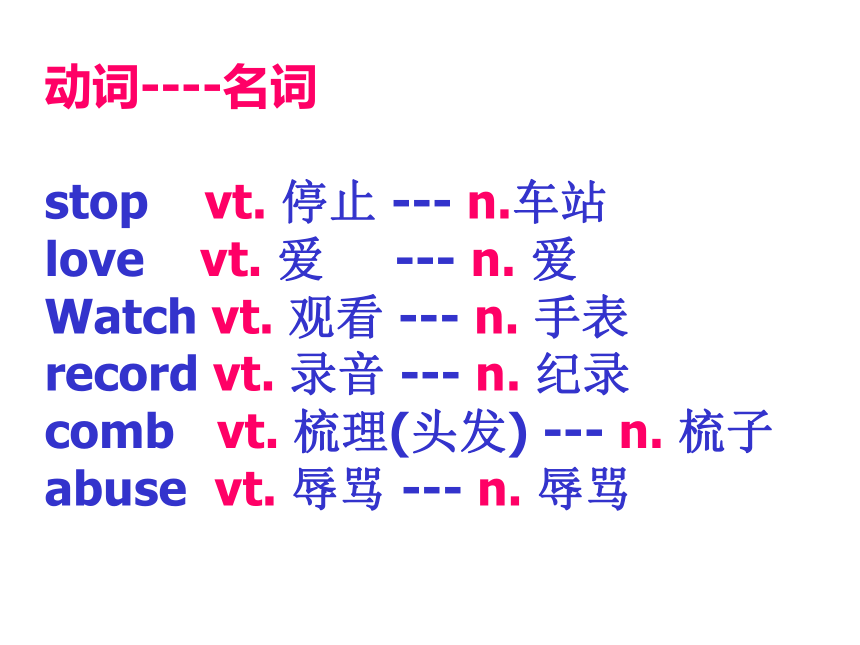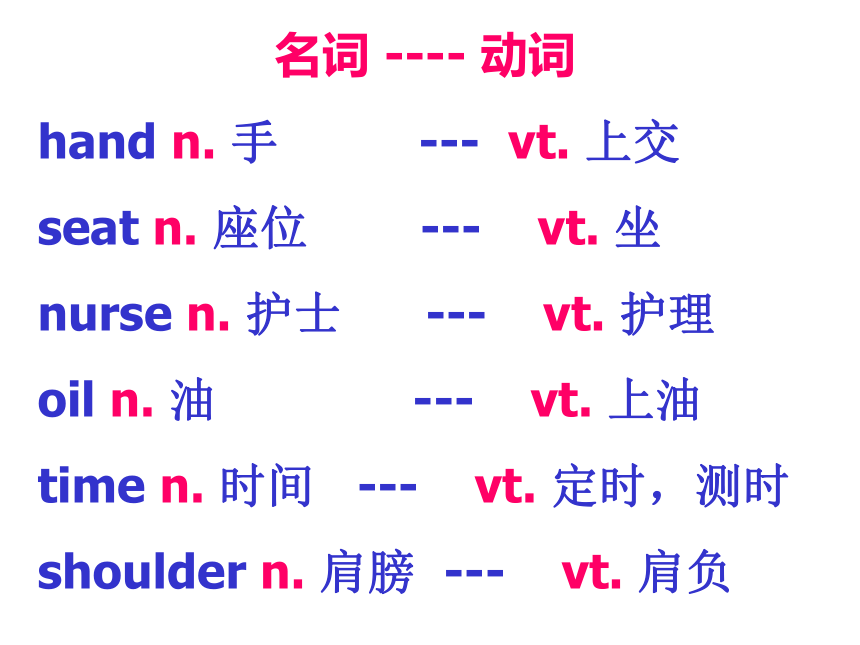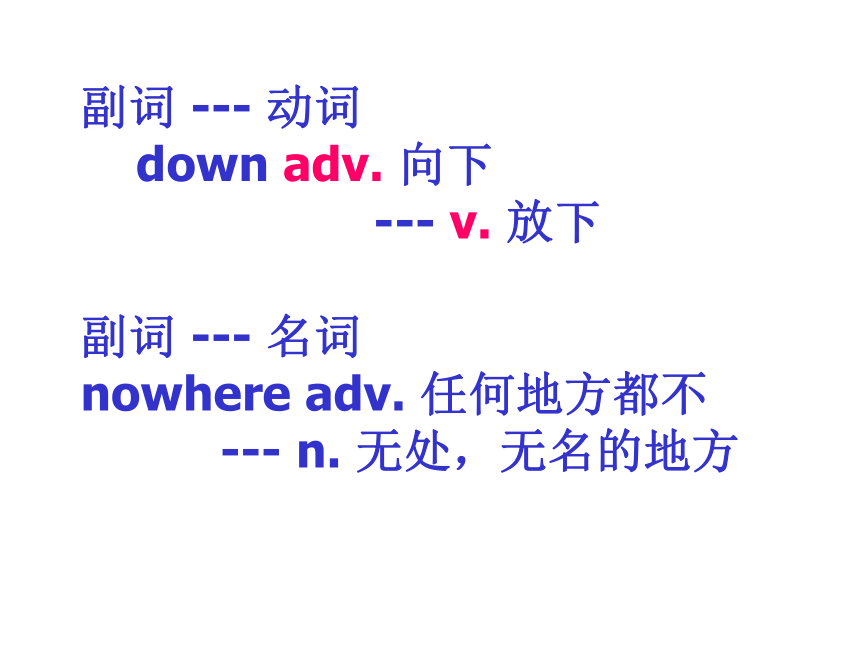高三英语 构词法复习课件(共88张)
图片预览












文档简介
课件88张PPT。英语构词法英语构词法主要有6种:
转化、合成、派生、截短、混合、首字母缩略
英语构词法种类转化法 英语构词法中把一种词性用作另一种词性而词形不变的方法叫作转化法,
1.动词转化为名词 I think we‘d better finish the talk now.
He is a man of strong build.
Let's have a look first. 2.名词转化为动词
Have you booked the ticket?
Hand in your papers please.
She nursed her husband back to health.
We breakfasted together. 3.形容词转化为动词 We will try our best to better our living conditions.
4.副词转化为动词 Murder will out.恶事终必将败露。
5.形容词转化为名词 The girl in black appears very beautiful.
We don't belong to the rich, but we don't belong to the poor either 动词----名词
stop vt. 停止 --- n.车站
love vt. 爱 --- n. 爱
Watch vt. 观看 --- n. 手表
record vt. 录音 --- n. 纪录
comb vt. 梳理(头发) --- n. 梳子
abuse vt. 辱骂 --- n. 辱骂
名词 ---- 动词
hand n. 手 --- vt. 上交
seat n. 座位 --- vt. 坐
nurse n. 护士 --- vt. 护理
oil n. 油 --- vt. 上油
time n. 时间 --- vt. 定时,测时
shoulder n. 肩膀 --- vt. 肩负mine n. 矿山 --- vt. 开矿
barbecue n. 烧烤---vt. 在烤架上烤
ship n. 船 --- vt. 用船装运
finance n. 金融--- vt. 为……提供资金
stain n. 污点,污迹 --- vt. 玷污,污染
draft n. 草稿 --- vt. 起草
head n. 头 --- v. 前进
transport n. 运输 --- vt. 运输
副词 --- 动词
down adv. 向下
--- v. 放下
副词 --- 名词
nowhere adv. 任何地方都不
--- n. 无处,无名的地方
形容词 --- 名词
freezing adj. 冰冻的 --- n. 冰点
solid adj. 固体的,坚实的--- n. 固体数词 --- 动词
second num. 第二 --- v. 赞成
--- n. 秒
2. 合成法 :
有两个或更多的词合成一个词。
class + room = classroom
warm + heart + ed = warmhearted
good + looking = good-looking1. 复合名词的主要构成方式
(1)名词+名词
blood-test验血;half-moon半月(形);silkworm蚕;classroom; airport
(2)形容词+名词
double-dealer两面派;shorthand速记;greenhouse温室
(3)V-ing+名词
reading-room;
meeting-room; swimming-pool(4)动词+名词
break-water防洪
pickpocket扒手
(5)名词+V-ing
handwriting
sun-bathing日光浴
(6)动词+副词
get-together联欢会;
breakthrough突破
(7)副词+动词
downfall垮台;outbreak爆发2. 复合形容词的主要构成方式
(1) 形容词 + 名词 +ed
cold-blooded冷血的;kind- hearted 心肠好的
(2)形容词+名词
high-class高级的
(3)形容词+V-ing
good-looking好看的;
easy-going随便的;
fine-sounding动听的
(4)形容词+过去分词
new-born新生的;ready-made现成的
(5)形容词+形容词
dark-blue深蓝色的;light-green浅绿色
(6)名词+ V-ing
life-saving救生的;ocean-going远洋的
(7)名词+过去分词
hand-made手工制的;
ice-covered冰雪覆盖的
(8)名词+形容词
nationwide全国性的;ice-cold冰冷的
(9)数词+名词+ed
one-eyed独眼的;two-faced双面的
(10)数词+名词 +形容词
five-year-old; two- metre-tall
3. 复合动词的主要构成方式
(1)名词+动词
sleep-walk梦游
(2)副词+动词
overcome克服; undergo经历 overthrow推翻;understand明白
(3)形容词+动词
white-wash粉刷;blacklist
列入黑名单4. 复合代词的主要构成方式
(1) 代词宾格或物主代词 + self (selves) herself 她自己;themselves 他们自己; ourselves我们自己
(2) 某些不定代词some(any,no,every) + body (one, thing) everyone; everybody; everything; anyone; any-body; anything; nothing; something3. 派生法 :
是通过在词根上加前缀或者后缀构成一个新词
happy --- unhappy
develop --- development前缀一般只引起意思上的变化而不造成词类的变化,只有少数能引起词类的变化
mis+ understand v.
--- misunderstand v. 误解
en + large adj. --- enlarge v. 1)表示否定意义的前缀常用的有dis-, il-, im-, in-, ir-, mis-, non-, un-等,在单词的前面加这类前缀常构成与该词意义相反的新词。例如: agree→disagree
fair→unfair
possible→impossible(2)表示其他意义的前缀常用的有a-(多构成表语形容词), anti- (反对;抵抗), auto- (自动), co- (共同), en- (使), inter- (互相), re- (再;又), sub- (下面的;次;小), tele- (强调距离)等。例如: co-worker 同事,帮手 enrich 使丰富cooperate 合作 rewrite 重写 subway 地铁 后缀
(1)构成名词的后缀常用的有-ence,-(e)r/ -or (从事某事的人),-ese (某地人),-ess (雌性),-ian (精通……的人),-ist (专业人员),-ment (性质;状态),-ness (性质;状态),-tion(动作;过程)等。例如:
differ→difference
write→writer China→Chinese act→actress music→musician
(2)构成动词的后缀常用的有-(e)n (多用于形容词之后),-fy (使……化),-ize (使……成为)。例如: wide→widen加宽 beauty→beautify美化 pure→purify提纯 real→realize意识到 organ→organize组织 sharp→sharpen使变锋利 (3)构成形容词的后缀常用的有-al,-able (有能力的),-(a)n(某国人的),-en (表示材料的名词后),-ern (方向的),-ese(某国人的),-ful,-(ic)al,-ish,-ive,-less (表示否定),-like (像……的),-ly,-ous,-some,-y (表示天气)等。例如: nature→natural reason→reasonable
America→American China→Chinese
gold→golden east→eastern child→childish snow→snowy(4)构成副词的常用后缀有-ly (主要用于形容词之后表示方式或程度),-ward(s) (主要用于表示方位的词之后表示方向)。例如: angry→angrily
to→towards
east→eastward(5)构成数词的后缀有-teen (十几),-ty (几十),-th (构成序数词)。例如: six六→sixteen十六→sixteenth第十六4. 截短法 :将单词缩写,词义和词性保持不变的英语构词法称为截短法,主要有截头、去尾、截头去尾等形式。
1.截头 telephone→phone airplane→plane
2.去尾 mathematics→maths examination→exam kilogram→kilo laboratory→lab taxicab→taxi
3.截头去尾 influenza→flu refrigerator→fridge prescription→script
5. 混合法 :英语构词还可以将两个词混合或各取一部分紧缩而成一个新词,前半部分表属性,后半部分表主体。这样的英语构词法就是混合法
breakfast lunch=brunch 早午餐
news broadcast→newscast新闻广播 television broadcast→telecast电视播送 smoke and fog→smog烟雾 photo and graphy→photography摄影,摄影术
helicopter airport→heliport直升飞机场
6.首字母缩略法TOEFL ----Test of English as a foreign language –托福
IELTS ---International English language test system 雅思
WHO WTO NBA VOA BBC 常见的前缀1)否定 ab-, abuse abnormal
dis- dishonest, dislike
in-, (il, im, ir, )
incapable, inability,
impossible,impatient,imbalance,
immoral, illegal, irregular
ne-, n-, none, neither, never
non-, nonsense nonstop nonresidence
un- unable, unemployment, uncommon,uncomfortable2)表示错误的意义 male-, mal-, malfunction, maladjustment(失调) mis-, mistake, mislead 3)表示反动作的意思 de-, decode, deforest, degrade,
dis-, disarm, disconnect un-, unload, uncover ,unfasten ,
undo 4)表示相反,相互对立意思 anti-, ant- antiknock( 防震), antiforeign,(排外的) antihero, anti-japanese ob-, oc-, of-, op-, object, oppose, occupy with-, withdraw, withstand (经受, ) 2. 表示空间位置,方向关系的前缀 1)a- 表示“在……之上”,“向……” aboard, aside, ahead
2)by- 表示“附近,邻近,边侧” bypath, bypass(弯路) bystander byproduct
3)circum-, circu-, 表示“周围,环绕,回转” circumstance, circuit(电路) 4)de-, 表示“在下,向下” descend, degrade 5)en-, 表示“在内,进入” encage, enbed(上床)
6)ex-, ec-, es-, 表示“外部,外” exit, eclipse, expand, export 7)extra-, 表示“额外”
extraction (提取)extraordinary 8)fore- 表示“在前面” forehead, foreground, forearm 9)in-, il-, im-, ir-, 表示“向内,在内背于” inland, invade, inside, import 10)inter-, intel-, 表示“在……间,相互” international, interaction, internet
11)intro-, 表示“向内,在内,内侧” introduce, 12)medi-, med-, mid-, 表示“中, 中间” Mediterranean, midposition
13)out-, 表示“在上面,在外部,在 外” outline, outside, outward 14)over-, 表示“在上面,在外部, 向上” overlook, overhead, overboard
overestimate, overstate 15)post-, 表示“向后,在后边,次” postscript(附言), 16)pre-, 表示“在前”在前面” prefix, preface, preposition
17)pro-, 表示“在前,向前” progress, proceed,
18)sub-, suc-, suf-, sug-, sum-, sup-, sur-, sus-, 表示“在下面,下” subway, subtitle,submarine, suffix, suppress(压制), supplement(补充) 19)super-, sur-, 表示“在…..之上” superficial, surface, superstructure (上部建筑)20)trans-, 表示“移上,转上,在那一边” translate, transform, transplant
transfer, 21)under-, 表示“在…..下面,下的” underline, underlie, underwater underground, underestimate
22)up-, 表示“向上,向上面,在上” upper,upward, uphold(举), uphill(上坡)
3. 表示时间,序列关系的前缀 1)ante-, anti-, 表示“先前,早于,预先” antecedent(先例), anticipate, 2)ex-, 表示“先,故,旧” expresident, exhusband 3)fore-, 表示“在前面,先前,前面” foreward, forecast, foretell(预言) 4)mid-, medi-, 表示“中,中间” midnight, midsummer ,medium 5)post-"表示“在后,后” postwar, 6)pre-, pri-, 表示“在前,事先,预先” preheat, prewar, prehistory 7)pro-, 表示“在前,先,前” prologue(序幕),prophet(预言家) 8)re-, 表示“再一次,重新” retell, rewrite ,review, 4. 表示比较程度差别关系的前缀 1)by-, 表示“副,次要的” byproduct, bywork(副业) 2)extra-,表示“超越,额外” extraordinary, 3)hyper- 表示“超过,极度” hypersonic(超声波), hypertesion(高血压)4)out-,表示“超过,过分” outdo(超过), outbid(出价过高的人) outrun,outgrow 5)over-,表示“超过,过度,太” overeat, overdress, oversleep 6) sub-, suc-, sur-, 表示“低,次,副,亚” subeditor, subordinate(从属), subtropical(亚热带) 7)super-, sur- 表示“超过” supernature, superpower, surplus, surpass 8)under-,表示“低劣,低下” undersize, undergrown, underproduction(生产不足) 9)vice- 表示“副,次” vicepresident, vicechairman5. 表示共同,相等意思的前缀 1)com-, cop-, con-, cor-, co- 表示“共同,一起”。 connect, combine, collect, combat(战斗), coexist, co-operate 2)syn-, syl-,sym-,表示“同,共,和,类” symmetry(对称), sympathy, synthesis(合成) 6. 表示整个完全意思的前缀 1)al- 表示“完整,完全”alone, almost, 2) over-表示“完全,全”overall, overflow(溢) 3) pan-表示“全,总,万”panentheism(泛神论),panorama (全景) 7. 表示分离,离开意思的前缀 1)a- ab-, abs-,表示“分离,离开” away, apart, abstract, abstain(戒除) 2)de- 表示“离去,处去”depart, decolour, 3)dis-, di-, dif-, 表示“分离,离开” divorce, disarm(缴械) 4)ex-, e-, 表示“离开,分离”
expel(驱赶), exclude, 5)for- 表示“离开,脱离”forget, forgive 6) re表示“离开”release, resolve 7) se表示“分离,隔离”
separate, select
8. 表示通过,遍及意思的前缀 1)dia-,表示“通过,横过”diameter, diagram(图表) 2)per-, pel-, 表示“通,总,遍”perfect, perform,
3)trans-, 表示“横过,贯通”transparent(透明的), transmit, transport 9. 表示加强意思的前缀 a-, arouse, ashamed ad-, adjoin(邻近), adhere( 粘着) 10. 表示变换词类作用的前缀 be-, befriend, en-, enslave, enable, enrich ad-, ac-, af-, ag-, an-, ap-, ar-, as-, at-, adapt, accord, affix, aggression, arrive, assist, attend, attract, arrange, assign(委派) 11. 表示数量关系的前缀 1)表示“单一”,“一” mon-, mon-, monotone(单调),monopoly, monarch(君主) uni-, un-, uniform, 2)表示“二,两,双” bi-, bin- bicycle, bilingual
di-, dialogue,
twi-, twilight 3)表示“十”deca, dec-
decade 4)表示"百,百分之一" centi-, centimeter 5)表示"千,千分子一” kilo-, kilometer,kilogram
6)表示"万,万分子一” micro-, microvolt (微伏特) 7)表示“许多,复,多数” multi-, mult-, multiple poly-, polysyllable(多音节), 8)表示“半,一半” hemi-,
hemisphere semi-, semiconductor, semitransparent, semiofficial 12. 表示特殊意义的前缀 1)arch-, 表示“首位,第一的,主要的”architect, archbishop(大主教) 2)auto-, 表示“自己,独立,自动”automobile, autobiography,automatic 3)bene-, 表示“善,福”benefit 4)eu-, 表示“优,美好”,euphemism(委婉语) 5)male-, mal- 表示“恶,不良”maltreatment, 6)macro-, 表示“大,宏大”macroscopic(宏观) macroeconomics 7)magni-, 表示“大”magnificent 8)micro-, 表示“微”microscope, microwave
13. 表示术语的前缀 1)aud-, 表示“听,声”audience,auditory(听觉的) 2)bio-, 表示“生命,物”biography(传记) biology
3)ge-, 表示“地球,大地”geography 4)phon-, 表示“声,音调”phonetics 5)tele-, 表示“远离”television, telephone
常见后缀1. 名词后缀 (1) 具有某种职业或动作的人 1)-an, -ain, 表示“……地方的人,精通……的人”American, historian, 2)-al, 表示“具有……职务的人” principal, 3)-ant,-ent, 表示“……者” merchant, agent, servant, student, 4)-ar, 表示“……的人” scholar, liar, peddler 5)-ard, -art, 表示“做……的人”coward, braggart(夸张者) 6)-arian, 表示“……派别的人, ……主义的人” vegetarian 7)-ary, 表示“从事……的人” secretary, missionary(传教士) 8)-ate, 表示"具有……职责的人" candidate, graduate 9)-ator, 表示"做……的人" educator, speculator(投机者) 10)-crat, 表示"某种政体,主义的支持者" democrat, 11)-ee, 表示"动作承受者" employee, examinee 12)-eer, 表示"从事于……人" engineer, volunteer 13)-er, 表示"从事某种职业的人, 某地区,地方的人" banker, observer, Londoner, villager 14)-ese, 表示" ……国人,…..地方的人”Japanese, Cantonese 15)-ess, 表示“阴性人称名词, actress, hostess, 16)-eur, 表示”……家” amateur, 17)-ian, 表示“……地方人,信仰…….教的人,从事……职业的人”Christian, physician(内科医生),musician 18)-ician, 表示“精通者, ……家,”electrician, magician, technician 19)-icist, 表示“…家, .者, ….能手”physicist, phoneticist, 20)-ic, 表示"……者,……师" mechanic, critic 21)-ine, ian, 表示"阴性人称" heroine, 22)-ist, 表示"从事……研究者,信仰……主义者" pianist, communist, dentist, artist, chemist 25)-ive, 表示"动作者,行为者” native, 26)-logist, 表示"……学家,研究者" biologist, geologist(地质学家) 27)-or, 表示"……者" author, doctor, operator, 28)-ster, 表示"做…….事情的人”youngster, gamester(赌徒), 29)-yer, 表示" 从事……职业者” lawyer
(2). 构成,具有抽象名词的含义 1)-acy, 表示"性质,状态,境遇" accuracy, diplomacy 2)-age, 表示"状态,行为,身份及其结果,总称" courage, storage, marriage 3)-al, a) 表示"事物的动作,过程”refusal, arrival, survival, denial, approval b) 表示具体的事物manual, signal, editorial, journal 4)-ance, -ence表示"性质,状况,行为,过程,总量,程度” endurance, importance, diligence, difference, obedience 5)-ancy, -ency, 表示"性质,状态,行为,过程" frequency, urgency, efficiency,
6)-bility, 表示"动作,性质,状态" possibility, feasibility, 7)-craft, 表示"工艺,技巧” woodcraft, handicraft, 8)-cracy, 表示"统治,支配", democracy 9)-cy, 表示"性质,状态,职位,级别" bankruptcy(破产),supremacy 10)-dom, 表示"等级,领域,状态" freedom, kingdom, wisdom 11)-ery, -ry, 表示"行为,状态,习性" bravery, bribery, rivalry 12)-ety, 表示"性质,状态” variety, 13)-faction, -facture, 表示"作成,……化,作用" satisfaction, manufacture14)-hood, 表示"资格,身份, 年纪,状态" childhood, manhood, falsehood 15)-ice, 表示"行为,性质,状态" notice, justice, service 16)-ine, 表示"带有抽象概念" medicine, discipline, famine 17)-ing, 表示"动作的过程,结果" building, writing, learning 18)-ion, -sion, -tion, -ation, -ition, 表示"行为的过程,结果,状况" action, solution, conclusion, destruction, expression, correction 19)-ise, 表示"性质,状态” exercise, merchandise(商业) 20)-ism, 表示"制度,主义,学说,信仰,行为" socialism, criticism, heroism21)-ity, 表示"性质,状态,程度” purity, reality, ability,
22)-ment, 表示"行为,状态,过程,手段及其结果 treatment, movement, judgment, punishment, argument 23)-mony, 表示"动作的结果,状态" ceremony, 24)-ness, 表示"性质,状态,程度" goodness, kindness, tiredness, friendliness 25)-or, -our, 表示"动作,性质,状态" favor, error, 26)-osity, 表示"动作,状态” curiosity 27)-ship, 表示"情况,性质,技巧,技能及身份,职业” hardship, membership, friendship28)-th, 表示“动作,性质,过程,状态” depth, wealth, truth, length, growth 29)-tude, 表示“性质,状态,程度” latitude(纬度), altitude(海拔) 30)-ure, 表示"行为,结果" exposure, pressure, failure, procedure(手续), 31)-y, 表示"行为的结果,状态,性质” glory, history, victory, inquiry (3) 带有场所,地方的含义 1)-age, 表示"住所,地点" village, cottage 2)-ary, 表示"住所,场地" library, 3)-ery, ry, 表示"工作场所,饲养所,地点" laundry, nursery, surgery(手术室) 4)-ory, 表示"工作场所,住处" factory, dormitory, laboratory, observatory (4) 带有学术,科技含义 1)-grapy, 表示“……学,写法” biography, calligraphy, geography 2)-ic, ics, 表示“……学……法” logic, mechanics, electronics 3)-ology, 表示“……学……论”biology, zoology, technology(工艺学) 4)-nomy, 表示“……学……术” astronomy(天文学), economy,
5)-ery, 表示"学科,技术" chemistry, machinery 6)-y, 表示“……学,术,法” photography, philosophy (5) 表示人和事物的总和,集合含义 1)-age, baggage, 2)-dom, newspaperdom(新闻界) 3)-hood, neighbourhood, womanhood 4)-ery, ministry(内阁) 5)-ure, legislature(立法机关), (6) 表示物品和物质名称的含义 1)-ant, ent, constant (常数) 2)-al, signal, pictorial(画报) 3)ar, collar(衣领), pillar(石柱) 4)- er, boiler, computer, washer, cooker 5)-ery, drapery(绸缎) 6)-ing, clothing, matting, 7)-ment, instrument, equipment, attachment (7) 表示“细小”的含义 1)-cle, particle, 2)-cule, molecule(分子) 3)-el, parcel 4)-en, chicken, maiden 5)-et, pocket, ticket 6)-etta, -ette, etto, cigarette, essayette(短文) 7)-kin, napkin 8)-ling, duckling(小鸭子) 9)-let, booklet 10)-y, baby, doggy 2. 形容词后缀 1.后缀–ful表示“充满…的,?有…性质的”,?如:?careful,?useful,?helpful,?hopeful,?powerful,?painful,?merciful? 2.后缀–less表示“无;?不做;?不能”,?如:?careless,?hopeless,?fatherless,?harmless,?rainless,?countless无数的,?speechless 3.后缀–able表示“能够;?适于…;?值得…”,?如:?eatable,?acceptable,?laughable可笑的,?comfortable? 4.后缀–ible表示“可(被)…的;?能…的”,?如:?responsible有责任的,?permissible可允许的,?divisible可分的,?possible 5.后缀–ic表示“与…有关的;?像…的;?由…产生的”,?如:?heroic英雄的,?historic有历史意义的,?atomic原子的,?energetic精力旺盛的,?electric电的 6.后缀–ive表示“拥有…的性质;?有…的倾向”,?如:?inventive发明的,?imaginative富有想象力的,?sensitive敏感的,?effective有效的,?expressive表情丰富的 7.后缀–ous表示“具有…的;?多…的;?有…特性的”,?如:?various,?nervous,?continuous连续的,?poisonous有毒的,?anxious,?mountainous多山的,?dangerous,?courageous英勇的 8.后缀–y表示“有…的;?由…构成,?似…的;?有点…的”,?如:?healthy,?wealthy,?rainy,?windy,?silky,?greedy,?smelly有臭味的 9.后缀–ly表示“像…的;?有…性质的;?反复发生的”,?如:?friendly,?motherly母亲似的,?manly在男子气的,?monthly每月的 10.后缀–ant表示“有…性质的”,?如:?important,?distant,?ignorant无知的 11.后缀–ent表示“…的状态”,?如:?different,?independent,?impatient,?frequent经常的,?excellent极好的 12.后缀–en表示“由…制的”,?如:?wooden,?woolen羊毛的,?golden金的 13.后缀–ern表示方向,?如:?western,?eastern,?northern,?southern? 14.后缀–al表示“像…的;?与…有关的”,?如:?personal,?electrical电的,?cultural,?natural,?national? 15.后缀–ish表示“似…的;?…的”,?如:?selfish自私的,?childish似孩童的,?foolish? 16.后缀–like表示“像…的”,?如:?childlike孩子般天真的,?godlike上帝般的,?lifelike栩栩如生的 17.后缀–ary表示“与…有关的;?…的”,?如:?revolutionary革命的,?imaginary虚构的,?momentary瞬间的,?primary首要的,?ordinary普通的 18.后缀–ed表示“有…的;?特有…的”,?如:?skilled有技术的,?talented有天赋的,?wooded林木茂密的 19.后缀–some表示“易于…的,?有…倾向的;?产生…的”,?如:?lonesome寂寞的,?handsome英俊的,?tiresome讨厌的,?fearsome可怕的,?burdensome沉重的 20.后缀–an表示“…的,?与…有关的,?…风格的”,?如:?Canadian加拿大的,?Australian澳大利亚的,?Mexican墨西哥的,?American,?European欧洲的 构成动词的后缀:? 1.后缀–ize?/?-ise表示“使成为,?使能够,?作…处理”,?如:?realize实现,?industrialize工业化,?mechanize机械化,?nationalize使国有化,?revolutionize使革命化,?modernize使现代化 2.后缀–ify表示“使成为…的;?使…化”,?如:?beautify美化,?terrify使惊吓,?electrify电气化,?magnify放大 3.后缀–en表示“使有,?使得”,?如:?strengthen加强,?deepen加深,?darken使变黑,?shorten使变短,?fasten扎牢 4.后缀–ate表示“使,?作为…”,?如:?activate使活动,?motivate激发,?liberate解放,?separate分开,?hibernate冬眠 构成副词的后缀:? 1.后缀-ly,?如:?really,?simply,?happily,?publicly,?happily,?lastly,?lately,?excitedly? 2.后缀–ward表示方向,?如:?upward,?inward,?westward,?homeward,?backward
转化、合成、派生、截短、混合、首字母缩略
英语构词法种类转化法 英语构词法中把一种词性用作另一种词性而词形不变的方法叫作转化法,
1.动词转化为名词 I think we‘d better finish the talk now.
He is a man of strong build.
Let's have a look first. 2.名词转化为动词
Have you booked the ticket?
Hand in your papers please.
She nursed her husband back to health.
We breakfasted together. 3.形容词转化为动词 We will try our best to better our living conditions.
4.副词转化为动词 Murder will out.恶事终必将败露。
5.形容词转化为名词 The girl in black appears very beautiful.
We don't belong to the rich, but we don't belong to the poor either 动词----名词
stop vt. 停止 --- n.车站
love vt. 爱 --- n. 爱
Watch vt. 观看 --- n. 手表
record vt. 录音 --- n. 纪录
comb vt. 梳理(头发) --- n. 梳子
abuse vt. 辱骂 --- n. 辱骂
名词 ---- 动词
hand n. 手 --- vt. 上交
seat n. 座位 --- vt. 坐
nurse n. 护士 --- vt. 护理
oil n. 油 --- vt. 上油
time n. 时间 --- vt. 定时,测时
shoulder n. 肩膀 --- vt. 肩负mine n. 矿山 --- vt. 开矿
barbecue n. 烧烤---vt. 在烤架上烤
ship n. 船 --- vt. 用船装运
finance n. 金融--- vt. 为……提供资金
stain n. 污点,污迹 --- vt. 玷污,污染
draft n. 草稿 --- vt. 起草
head n. 头 --- v. 前进
transport n. 运输 --- vt. 运输
副词 --- 动词
down adv. 向下
--- v. 放下
副词 --- 名词
nowhere adv. 任何地方都不
--- n. 无处,无名的地方
形容词 --- 名词
freezing adj. 冰冻的 --- n. 冰点
solid adj. 固体的,坚实的--- n. 固体数词 --- 动词
second num. 第二 --- v. 赞成
--- n. 秒
2. 合成法 :
有两个或更多的词合成一个词。
class + room = classroom
warm + heart + ed = warmhearted
good + looking = good-looking1. 复合名词的主要构成方式
(1)名词+名词
blood-test验血;half-moon半月(形);silkworm蚕;classroom; airport
(2)形容词+名词
double-dealer两面派;shorthand速记;greenhouse温室
(3)V-ing+名词
reading-room;
meeting-room; swimming-pool(4)动词+名词
break-water防洪
pickpocket扒手
(5)名词+V-ing
handwriting
sun-bathing日光浴
(6)动词+副词
get-together联欢会;
breakthrough突破
(7)副词+动词
downfall垮台;outbreak爆发2. 复合形容词的主要构成方式
(1) 形容词 + 名词 +ed
cold-blooded冷血的;kind- hearted 心肠好的
(2)形容词+名词
high-class高级的
(3)形容词+V-ing
good-looking好看的;
easy-going随便的;
fine-sounding动听的
(4)形容词+过去分词
new-born新生的;ready-made现成的
(5)形容词+形容词
dark-blue深蓝色的;light-green浅绿色
(6)名词+ V-ing
life-saving救生的;ocean-going远洋的
(7)名词+过去分词
hand-made手工制的;
ice-covered冰雪覆盖的
(8)名词+形容词
nationwide全国性的;ice-cold冰冷的
(9)数词+名词+ed
one-eyed独眼的;two-faced双面的
(10)数词+名词 +形容词
five-year-old; two- metre-tall
3. 复合动词的主要构成方式
(1)名词+动词
sleep-walk梦游
(2)副词+动词
overcome克服; undergo经历 overthrow推翻;understand明白
(3)形容词+动词
white-wash粉刷;blacklist
列入黑名单4. 复合代词的主要构成方式
(1) 代词宾格或物主代词 + self (selves) herself 她自己;themselves 他们自己; ourselves我们自己
(2) 某些不定代词some(any,no,every) + body (one, thing) everyone; everybody; everything; anyone; any-body; anything; nothing; something3. 派生法 :
是通过在词根上加前缀或者后缀构成一个新词
happy --- unhappy
develop --- development前缀一般只引起意思上的变化而不造成词类的变化,只有少数能引起词类的变化
mis+ understand v.
--- misunderstand v. 误解
en + large adj. --- enlarge v. 1)表示否定意义的前缀常用的有dis-, il-, im-, in-, ir-, mis-, non-, un-等,在单词的前面加这类前缀常构成与该词意义相反的新词。例如: agree→disagree
fair→unfair
possible→impossible(2)表示其他意义的前缀常用的有a-(多构成表语形容词), anti- (反对;抵抗), auto- (自动), co- (共同), en- (使), inter- (互相), re- (再;又), sub- (下面的;次;小), tele- (强调距离)等。例如: co-worker 同事,帮手 enrich 使丰富cooperate 合作 rewrite 重写 subway 地铁 后缀
(1)构成名词的后缀常用的有-ence,-(e)r/ -or (从事某事的人),-ese (某地人),-ess (雌性),-ian (精通……的人),-ist (专业人员),-ment (性质;状态),-ness (性质;状态),-tion(动作;过程)等。例如:
differ→difference
write→writer China→Chinese act→actress music→musician
(2)构成动词的后缀常用的有-(e)n (多用于形容词之后),-fy (使……化),-ize (使……成为)。例如: wide→widen加宽 beauty→beautify美化 pure→purify提纯 real→realize意识到 organ→organize组织 sharp→sharpen使变锋利 (3)构成形容词的后缀常用的有-al,-able (有能力的),-(a)n(某国人的),-en (表示材料的名词后),-ern (方向的),-ese(某国人的),-ful,-(ic)al,-ish,-ive,-less (表示否定),-like (像……的),-ly,-ous,-some,-y (表示天气)等。例如: nature→natural reason→reasonable
America→American China→Chinese
gold→golden east→eastern child→childish snow→snowy(4)构成副词的常用后缀有-ly (主要用于形容词之后表示方式或程度),-ward(s) (主要用于表示方位的词之后表示方向)。例如: angry→angrily
to→towards
east→eastward(5)构成数词的后缀有-teen (十几),-ty (几十),-th (构成序数词)。例如: six六→sixteen十六→sixteenth第十六4. 截短法 :将单词缩写,词义和词性保持不变的英语构词法称为截短法,主要有截头、去尾、截头去尾等形式。
1.截头 telephone→phone airplane→plane
2.去尾 mathematics→maths examination→exam kilogram→kilo laboratory→lab taxicab→taxi
3.截头去尾 influenza→flu refrigerator→fridge prescription→script
5. 混合法 :英语构词还可以将两个词混合或各取一部分紧缩而成一个新词,前半部分表属性,后半部分表主体。这样的英语构词法就是混合法
breakfast lunch=brunch 早午餐
news broadcast→newscast新闻广播 television broadcast→telecast电视播送 smoke and fog→smog烟雾 photo and graphy→photography摄影,摄影术
helicopter airport→heliport直升飞机场
6.首字母缩略法TOEFL ----Test of English as a foreign language –托福
IELTS ---International English language test system 雅思
WHO WTO NBA VOA BBC 常见的前缀1)否定 ab-, abuse abnormal
dis- dishonest, dislike
in-, (il, im, ir, )
incapable, inability,
impossible,impatient,imbalance,
immoral, illegal, irregular
ne-, n-, none, neither, never
non-, nonsense nonstop nonresidence
un- unable, unemployment, uncommon,uncomfortable2)表示错误的意义 male-, mal-, malfunction, maladjustment(失调) mis-, mistake, mislead 3)表示反动作的意思 de-, decode, deforest, degrade,
dis-, disarm, disconnect un-, unload, uncover ,unfasten ,
undo 4)表示相反,相互对立意思 anti-, ant- antiknock( 防震), antiforeign,(排外的) antihero, anti-japanese ob-, oc-, of-, op-, object, oppose, occupy with-, withdraw, withstand (经受, ) 2. 表示空间位置,方向关系的前缀 1)a- 表示“在……之上”,“向……” aboard, aside, ahead
2)by- 表示“附近,邻近,边侧” bypath, bypass(弯路) bystander byproduct
3)circum-, circu-, 表示“周围,环绕,回转” circumstance, circuit(电路) 4)de-, 表示“在下,向下” descend, degrade 5)en-, 表示“在内,进入” encage, enbed(上床)
6)ex-, ec-, es-, 表示“外部,外” exit, eclipse, expand, export 7)extra-, 表示“额外”
extraction (提取)extraordinary 8)fore- 表示“在前面” forehead, foreground, forearm 9)in-, il-, im-, ir-, 表示“向内,在内背于” inland, invade, inside, import 10)inter-, intel-, 表示“在……间,相互” international, interaction, internet
11)intro-, 表示“向内,在内,内侧” introduce, 12)medi-, med-, mid-, 表示“中, 中间” Mediterranean, midposition
13)out-, 表示“在上面,在外部,在 外” outline, outside, outward 14)over-, 表示“在上面,在外部, 向上” overlook, overhead, overboard
overestimate, overstate 15)post-, 表示“向后,在后边,次” postscript(附言), 16)pre-, 表示“在前”在前面” prefix, preface, preposition
17)pro-, 表示“在前,向前” progress, proceed,
18)sub-, suc-, suf-, sug-, sum-, sup-, sur-, sus-, 表示“在下面,下” subway, subtitle,submarine, suffix, suppress(压制), supplement(补充) 19)super-, sur-, 表示“在…..之上” superficial, surface, superstructure (上部建筑)20)trans-, 表示“移上,转上,在那一边” translate, transform, transplant
transfer, 21)under-, 表示“在…..下面,下的” underline, underlie, underwater underground, underestimate
22)up-, 表示“向上,向上面,在上” upper,upward, uphold(举), uphill(上坡)
3. 表示时间,序列关系的前缀 1)ante-, anti-, 表示“先前,早于,预先” antecedent(先例), anticipate, 2)ex-, 表示“先,故,旧” expresident, exhusband 3)fore-, 表示“在前面,先前,前面” foreward, forecast, foretell(预言) 4)mid-, medi-, 表示“中,中间” midnight, midsummer ,medium 5)post-"表示“在后,后” postwar, 6)pre-, pri-, 表示“在前,事先,预先” preheat, prewar, prehistory 7)pro-, 表示“在前,先,前” prologue(序幕),prophet(预言家) 8)re-, 表示“再一次,重新” retell, rewrite ,review, 4. 表示比较程度差别关系的前缀 1)by-, 表示“副,次要的” byproduct, bywork(副业) 2)extra-,表示“超越,额外” extraordinary, 3)hyper- 表示“超过,极度” hypersonic(超声波), hypertesion(高血压)4)out-,表示“超过,过分” outdo(超过), outbid(出价过高的人) outrun,outgrow 5)over-,表示“超过,过度,太” overeat, overdress, oversleep 6) sub-, suc-, sur-, 表示“低,次,副,亚” subeditor, subordinate(从属), subtropical(亚热带) 7)super-, sur- 表示“超过” supernature, superpower, surplus, surpass 8)under-,表示“低劣,低下” undersize, undergrown, underproduction(生产不足) 9)vice- 表示“副,次” vicepresident, vicechairman5. 表示共同,相等意思的前缀 1)com-, cop-, con-, cor-, co- 表示“共同,一起”。 connect, combine, collect, combat(战斗), coexist, co-operate 2)syn-, syl-,sym-,表示“同,共,和,类” symmetry(对称), sympathy, synthesis(合成) 6. 表示整个完全意思的前缀 1)al- 表示“完整,完全”alone, almost, 2) over-表示“完全,全”overall, overflow(溢) 3) pan-表示“全,总,万”panentheism(泛神论),panorama (全景) 7. 表示分离,离开意思的前缀 1)a- ab-, abs-,表示“分离,离开” away, apart, abstract, abstain(戒除) 2)de- 表示“离去,处去”depart, decolour, 3)dis-, di-, dif-, 表示“分离,离开” divorce, disarm(缴械) 4)ex-, e-, 表示“离开,分离”
expel(驱赶), exclude, 5)for- 表示“离开,脱离”forget, forgive 6) re表示“离开”release, resolve 7) se表示“分离,隔离”
separate, select
8. 表示通过,遍及意思的前缀 1)dia-,表示“通过,横过”diameter, diagram(图表) 2)per-, pel-, 表示“通,总,遍”perfect, perform,
3)trans-, 表示“横过,贯通”transparent(透明的), transmit, transport 9. 表示加强意思的前缀 a-, arouse, ashamed ad-, adjoin(邻近), adhere( 粘着) 10. 表示变换词类作用的前缀 be-, befriend, en-, enslave, enable, enrich ad-, ac-, af-, ag-, an-, ap-, ar-, as-, at-, adapt, accord, affix, aggression, arrive, assist, attend, attract, arrange, assign(委派) 11. 表示数量关系的前缀 1)表示“单一”,“一” mon-, mon-, monotone(单调),monopoly, monarch(君主) uni-, un-, uniform, 2)表示“二,两,双” bi-, bin- bicycle, bilingual
di-, dialogue,
twi-, twilight 3)表示“十”deca, dec-
decade 4)表示"百,百分之一" centi-, centimeter 5)表示"千,千分子一” kilo-, kilometer,kilogram
6)表示"万,万分子一” micro-, microvolt (微伏特) 7)表示“许多,复,多数” multi-, mult-, multiple poly-, polysyllable(多音节), 8)表示“半,一半” hemi-,
hemisphere semi-, semiconductor, semitransparent, semiofficial 12. 表示特殊意义的前缀 1)arch-, 表示“首位,第一的,主要的”architect, archbishop(大主教) 2)auto-, 表示“自己,独立,自动”automobile, autobiography,automatic 3)bene-, 表示“善,福”benefit 4)eu-, 表示“优,美好”,euphemism(委婉语) 5)male-, mal- 表示“恶,不良”maltreatment, 6)macro-, 表示“大,宏大”macroscopic(宏观) macroeconomics 7)magni-, 表示“大”magnificent 8)micro-, 表示“微”microscope, microwave
13. 表示术语的前缀 1)aud-, 表示“听,声”audience,auditory(听觉的) 2)bio-, 表示“生命,物”biography(传记) biology
3)ge-, 表示“地球,大地”geography 4)phon-, 表示“声,音调”phonetics 5)tele-, 表示“远离”television, telephone
常见后缀1. 名词后缀 (1) 具有某种职业或动作的人 1)-an, -ain, 表示“……地方的人,精通……的人”American, historian, 2)-al, 表示“具有……职务的人” principal, 3)-ant,-ent, 表示“……者” merchant, agent, servant, student, 4)-ar, 表示“……的人” scholar, liar, peddler 5)-ard, -art, 表示“做……的人”coward, braggart(夸张者) 6)-arian, 表示“……派别的人, ……主义的人” vegetarian 7)-ary, 表示“从事……的人” secretary, missionary(传教士) 8)-ate, 表示"具有……职责的人" candidate, graduate 9)-ator, 表示"做……的人" educator, speculator(投机者) 10)-crat, 表示"某种政体,主义的支持者" democrat, 11)-ee, 表示"动作承受者" employee, examinee 12)-eer, 表示"从事于……人" engineer, volunteer 13)-er, 表示"从事某种职业的人, 某地区,地方的人" banker, observer, Londoner, villager 14)-ese, 表示" ……国人,…..地方的人”Japanese, Cantonese 15)-ess, 表示“阴性人称名词, actress, hostess, 16)-eur, 表示”……家” amateur, 17)-ian, 表示“……地方人,信仰…….教的人,从事……职业的人”Christian, physician(内科医生),musician 18)-ician, 表示“精通者, ……家,”electrician, magician, technician 19)-icist, 表示“…家, .者, ….能手”physicist, phoneticist, 20)-ic, 表示"……者,……师" mechanic, critic 21)-ine, ian, 表示"阴性人称" heroine, 22)-ist, 表示"从事……研究者,信仰……主义者" pianist, communist, dentist, artist, chemist 25)-ive, 表示"动作者,行为者” native, 26)-logist, 表示"……学家,研究者" biologist, geologist(地质学家) 27)-or, 表示"……者" author, doctor, operator, 28)-ster, 表示"做…….事情的人”youngster, gamester(赌徒), 29)-yer, 表示" 从事……职业者” lawyer
(2). 构成,具有抽象名词的含义 1)-acy, 表示"性质,状态,境遇" accuracy, diplomacy 2)-age, 表示"状态,行为,身份及其结果,总称" courage, storage, marriage 3)-al, a) 表示"事物的动作,过程”refusal, arrival, survival, denial, approval b) 表示具体的事物manual, signal, editorial, journal 4)-ance, -ence表示"性质,状况,行为,过程,总量,程度” endurance, importance, diligence, difference, obedience 5)-ancy, -ency, 表示"性质,状态,行为,过程" frequency, urgency, efficiency,
6)-bility, 表示"动作,性质,状态" possibility, feasibility, 7)-craft, 表示"工艺,技巧” woodcraft, handicraft, 8)-cracy, 表示"统治,支配", democracy 9)-cy, 表示"性质,状态,职位,级别" bankruptcy(破产),supremacy 10)-dom, 表示"等级,领域,状态" freedom, kingdom, wisdom 11)-ery, -ry, 表示"行为,状态,习性" bravery, bribery, rivalry 12)-ety, 表示"性质,状态” variety, 13)-faction, -facture, 表示"作成,……化,作用" satisfaction, manufacture14)-hood, 表示"资格,身份, 年纪,状态" childhood, manhood, falsehood 15)-ice, 表示"行为,性质,状态" notice, justice, service 16)-ine, 表示"带有抽象概念" medicine, discipline, famine 17)-ing, 表示"动作的过程,结果" building, writing, learning 18)-ion, -sion, -tion, -ation, -ition, 表示"行为的过程,结果,状况" action, solution, conclusion, destruction, expression, correction 19)-ise, 表示"性质,状态” exercise, merchandise(商业) 20)-ism, 表示"制度,主义,学说,信仰,行为" socialism, criticism, heroism21)-ity, 表示"性质,状态,程度” purity, reality, ability,
22)-ment, 表示"行为,状态,过程,手段及其结果 treatment, movement, judgment, punishment, argument 23)-mony, 表示"动作的结果,状态" ceremony, 24)-ness, 表示"性质,状态,程度" goodness, kindness, tiredness, friendliness 25)-or, -our, 表示"动作,性质,状态" favor, error, 26)-osity, 表示"动作,状态” curiosity 27)-ship, 表示"情况,性质,技巧,技能及身份,职业” hardship, membership, friendship28)-th, 表示“动作,性质,过程,状态” depth, wealth, truth, length, growth 29)-tude, 表示“性质,状态,程度” latitude(纬度), altitude(海拔) 30)-ure, 表示"行为,结果" exposure, pressure, failure, procedure(手续), 31)-y, 表示"行为的结果,状态,性质” glory, history, victory, inquiry (3) 带有场所,地方的含义 1)-age, 表示"住所,地点" village, cottage 2)-ary, 表示"住所,场地" library, 3)-ery, ry, 表示"工作场所,饲养所,地点" laundry, nursery, surgery(手术室) 4)-ory, 表示"工作场所,住处" factory, dormitory, laboratory, observatory (4) 带有学术,科技含义 1)-grapy, 表示“……学,写法” biography, calligraphy, geography 2)-ic, ics, 表示“……学……法” logic, mechanics, electronics 3)-ology, 表示“……学……论”biology, zoology, technology(工艺学) 4)-nomy, 表示“……学……术” astronomy(天文学), economy,
5)-ery, 表示"学科,技术" chemistry, machinery 6)-y, 表示“……学,术,法” photography, philosophy (5) 表示人和事物的总和,集合含义 1)-age, baggage, 2)-dom, newspaperdom(新闻界) 3)-hood, neighbourhood, womanhood 4)-ery, ministry(内阁) 5)-ure, legislature(立法机关), (6) 表示物品和物质名称的含义 1)-ant, ent, constant (常数) 2)-al, signal, pictorial(画报) 3)ar, collar(衣领), pillar(石柱) 4)- er, boiler, computer, washer, cooker 5)-ery, drapery(绸缎) 6)-ing, clothing, matting, 7)-ment, instrument, equipment, attachment (7) 表示“细小”的含义 1)-cle, particle, 2)-cule, molecule(分子) 3)-el, parcel 4)-en, chicken, maiden 5)-et, pocket, ticket 6)-etta, -ette, etto, cigarette, essayette(短文) 7)-kin, napkin 8)-ling, duckling(小鸭子) 9)-let, booklet 10)-y, baby, doggy 2. 形容词后缀 1.后缀–ful表示“充满…的,?有…性质的”,?如:?careful,?useful,?helpful,?hopeful,?powerful,?painful,?merciful? 2.后缀–less表示“无;?不做;?不能”,?如:?careless,?hopeless,?fatherless,?harmless,?rainless,?countless无数的,?speechless 3.后缀–able表示“能够;?适于…;?值得…”,?如:?eatable,?acceptable,?laughable可笑的,?comfortable? 4.后缀–ible表示“可(被)…的;?能…的”,?如:?responsible有责任的,?permissible可允许的,?divisible可分的,?possible 5.后缀–ic表示“与…有关的;?像…的;?由…产生的”,?如:?heroic英雄的,?historic有历史意义的,?atomic原子的,?energetic精力旺盛的,?electric电的 6.后缀–ive表示“拥有…的性质;?有…的倾向”,?如:?inventive发明的,?imaginative富有想象力的,?sensitive敏感的,?effective有效的,?expressive表情丰富的 7.后缀–ous表示“具有…的;?多…的;?有…特性的”,?如:?various,?nervous,?continuous连续的,?poisonous有毒的,?anxious,?mountainous多山的,?dangerous,?courageous英勇的 8.后缀–y表示“有…的;?由…构成,?似…的;?有点…的”,?如:?healthy,?wealthy,?rainy,?windy,?silky,?greedy,?smelly有臭味的 9.后缀–ly表示“像…的;?有…性质的;?反复发生的”,?如:?friendly,?motherly母亲似的,?manly在男子气的,?monthly每月的 10.后缀–ant表示“有…性质的”,?如:?important,?distant,?ignorant无知的 11.后缀–ent表示“…的状态”,?如:?different,?independent,?impatient,?frequent经常的,?excellent极好的 12.后缀–en表示“由…制的”,?如:?wooden,?woolen羊毛的,?golden金的 13.后缀–ern表示方向,?如:?western,?eastern,?northern,?southern? 14.后缀–al表示“像…的;?与…有关的”,?如:?personal,?electrical电的,?cultural,?natural,?national? 15.后缀–ish表示“似…的;?…的”,?如:?selfish自私的,?childish似孩童的,?foolish? 16.后缀–like表示“像…的”,?如:?childlike孩子般天真的,?godlike上帝般的,?lifelike栩栩如生的 17.后缀–ary表示“与…有关的;?…的”,?如:?revolutionary革命的,?imaginary虚构的,?momentary瞬间的,?primary首要的,?ordinary普通的 18.后缀–ed表示“有…的;?特有…的”,?如:?skilled有技术的,?talented有天赋的,?wooded林木茂密的 19.后缀–some表示“易于…的,?有…倾向的;?产生…的”,?如:?lonesome寂寞的,?handsome英俊的,?tiresome讨厌的,?fearsome可怕的,?burdensome沉重的 20.后缀–an表示“…的,?与…有关的,?…风格的”,?如:?Canadian加拿大的,?Australian澳大利亚的,?Mexican墨西哥的,?American,?European欧洲的 构成动词的后缀:? 1.后缀–ize?/?-ise表示“使成为,?使能够,?作…处理”,?如:?realize实现,?industrialize工业化,?mechanize机械化,?nationalize使国有化,?revolutionize使革命化,?modernize使现代化 2.后缀–ify表示“使成为…的;?使…化”,?如:?beautify美化,?terrify使惊吓,?electrify电气化,?magnify放大 3.后缀–en表示“使有,?使得”,?如:?strengthen加强,?deepen加深,?darken使变黑,?shorten使变短,?fasten扎牢 4.后缀–ate表示“使,?作为…”,?如:?activate使活动,?motivate激发,?liberate解放,?separate分开,?hibernate冬眠 构成副词的后缀:? 1.后缀-ly,?如:?really,?simply,?happily,?publicly,?happily,?lastly,?lately,?excitedly? 2.后缀–ward表示方向,?如:?upward,?inward,?westward,?homeward,?backward
